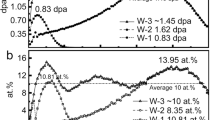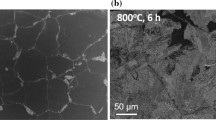Abstract
The results of positron lifetime and Doppler broadening spectrum of defects in the hydrogen charged non-heat treatable 5xxx Al alloys are presented in this work. The yield stress of the sample was reduced for about 20 MPa after hydrogen was charged. A similar trend was observed in positron lifetime measurement, as the average lifetime τav descended remarkably to almost the level of Al matrix. The change in coincidence Doppler broadening (CDB) spectroscopy was also significant, exhibited by the characteristic change in CDB radio curves of a sample before and after hydrogen was charged. After hydrogen charging, there is an obvious enhancement in the high momentum region compensating dehancement in the low momentum region. This indicates the existence of hydrogen filling effect. The vacancies around the Mg atoms should be preferential filling sites for hydrogen because Mg has a strong affinity for hydrogen. The formation of an Mg-H bond parallel to a grain boundary is an important factor in weakening the grain boundary cohesion.
Similar content being viewed by others
References
I.J. Polmear: Light Alloys—Metallurgy of the Light Metals, 3rd ed. (Arnold, a division of Hodder Headline PLC, London, 1995).
ASM: Metals Handbook, Properties and Selection: Nonferrous Alloys and Special-Purpose Materials, Vol. 2, 10th ed. (ASM International, Materials Park, OH, 1990).
H. Zhang and J. Senkara: Resistance Welding: Fundamentals and Applications (CRC Press/Taylor & Francis Group, Boca Raton, London, New York, 2006).
X. Wang, H. Zhang, and A. Sun: Influence of vacancy formation and Mg migration on cracking in spot welding AA5754 alloys. Mater. Sci. Forum 539–543, 433 (2007).
X. Liu, X. Wang, J. Wang, and H. Zhang: First-principles investigation of Mg segregation at Σ = 11(113) grain boundaries in Al. J. Phys: Condens. Matter 17, 1 (2005).
X. Liu, X. Wang, J. Wang, and H. Zhang: Effect of interstitial hydrogen on cohensive strength of Al grain boundary with Mg segregation. J. Mar. Sci. Technol. 22, 135 (2006).
S. Adhikari, J. Lee, H. Chen, Y.C. Jean, and K.R. Hebert: Injection of hydrogen and vacancy-type defects during dissolution of aluminum. ECS Transactions 1 (4), 127 (2005).
A. Seeger: The study of defects in crystals by positron annihilation. Appl. Phys. 4, 183 (1974).
Y. Nagai, M. Murayama, Z. Tang, T. Nonaka, K. Hono, and M. Hasegawa: Role of vacancy-solute complex in the initial rapid age hardening in an Al–Cu–Mg alloy. Acta Mater. 49, 913 (2001).
C-H. Huang, L. Ma, Z-Q. Chen, Z. Wang, X. Wang, and H. Zhang: An experimental study of Mg aggregation in AA5754 alloys by positron annihilation spectroscopy. Chin. Phys. Lett. 24, 546 (2007).
Author information
Authors and Affiliations
Corresponding author
Rights and permissions
About this article
Cite this article
Wang, X., Zhong, Y., Wang, B. et al. Positron lifetime and Doppler broadening study of defects in hydrogen charged Al-Mg alloys. Journal of Materials Research 24, 1791–1794 (2009). https://doi.org/10.1557/jmr.2009.0195
Received:
Accepted:
Published:
Issue Date:
DOI: https://doi.org/10.1557/jmr.2009.0195




